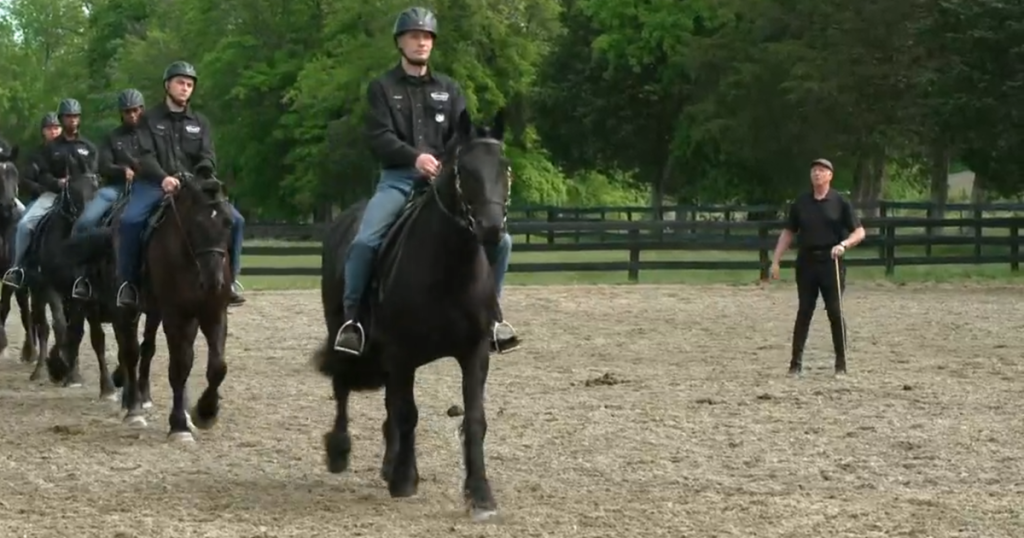In Arlington, Virginia, soldiers from the U.S. Army’s Old Guard are preparing to resume their honored role of conducting horse-drawn funerals at Arlington National Cemetery, after a temporary suspension. This traditional practice was halted in May 2023 following the death of two horses and subsequent investigations into their working conditions. As they gear up for the return of these ceremonial duties, commanders have enlisted the help of equestrian experts to ensure the well-being of the horses and improve operational efficiencies.
| Article Subheadings |
|---|
| 1) Background of the Horse-Drawn Funerals |
| 2) The Investigation and Findings |
| 3) Changes in Practice and Equipment |
| 4) Intensive Training for Soldiers |
| 5) Emotional Significance of the Duties |
Background of the Horse-Drawn Funerals
The U.S. Army’s Old Guard has historically been responsible for performing military honors at Arlington National Cemetery, utilizing horse-drawn caissons as part of this solemn duty. This practice symbolizes honor and respect for the service members being laid to rest, and serves as a reminder of the sacrifices made in defense of the country. Known for its ceremonial grandeur, horse-drawn funerals have become an essential component of military traditions in the United States, with the Old Guard being the only active duty infantry regiment tasked with this important mission. The caisson, a vehicle used to transport coffins, reinforces the military’s reverence for fallen heroes.
The Investigation and Findings
In May 2023, the Army suspended horse-drawn funerals following the tragic deaths of two horses within just 96 hours. An investigation revealed that several horses were experiencing significant health problems, including painful muscle and tendon injuries that were exacerbated by their rigorous work schedule. The Army determined that many horses had been subjected to excessive labor, conducting as many as eight funerals a day without adequate rest. Subsequently, 27 horses were sent to various rehabilitation facilities to recover from their ailments. In response, the Army replaced horse-drawn caissons with hearses, temporarily discontinuing the traditional practice while addressing the welfare of the animals involved.
Changes in Practice and Equipment
As the Army laid the groundwork for the return of horse-drawn funerals, it implemented several significant changes. One of the most critical improvements was the introduction of new horses, departing from the retired ones, which were no longer able to fulfill their duties due to age and health concerns. Additionally, the old caisson design, which weighed approximately 2,600 pounds, has been replaced with a new model that is over 1,000 pounds lighter. This reduction in weight aims to alleviate the strain on the horses while improving their overall performance during the ceremonies. By focusing on both the treatment of the animals and improvements to the equipment, the Army embraced a holistic approach in its preparation to resume these ceremonial duties.
Intensive Training for Soldiers
Recognizing the operational challenges they faced, the Old Guard’s leadership sought the help of equestrian experts, enlisting the skills of professional horse trainers, including Olympic gold medalist David O’Connor. Army personnel have undergone extensive training to ensure they understand horse care, behavior, and effective handling techniques. For some soldiers, like Staff Sgt. Isaac Melton, this training has been a new experience, as he previously had no background with horses. In order to prepare, training sessions have averaged around 8 to 10 hours per day. Leadership acknowledges the need to ensure that soldiers not only grasp the technical aspects associated with the horses but also immerse themselves in the emotional weight of the responsibilities they are assuming.
Emotional Significance of the Duties
For many soldiers, returning to horse-drawn funerals is more than a job; it is a deeply emotional experience that connects them to the sacrifices made by their fellow service members. Sgt. Daimien Copeland, who was part of the program before its suspension, expressed his mixed feelings of pride, excitement, and nervousness about resuming the tradition. The return to horse-drawn funerals provides an opportunity for soldiers to honor the lives of those who have served, connecting them intimately with the stories and sacrifices of their comrades. The resumption of this essential duty can be seen as a bridge between the past and present, reminding families and friends that their loved ones’ commitments are forever appreciated.
| No. | Key Points |
|---|---|
| 1 | Horse-drawn funerals at Arlington National Cemetery serve as a solemn tradition honoring fallen service members. |
| 2 | The Army suspended these funerals due to health issues affecting the horses, prompting an investigation. |
| 3 | New health and equipment standards aim to improve the care and performance of the horses involved. |
| 4 | Intensive training for soldiers is critical to ensuring proper equestrian handling and care. |
| 5 | Many soldiers view their roles in these funerals as a profound honor and source of emotional connection. |
Summary
The return of horse-drawn funerals by the U.S. Army’s Old Guard symbolizes a renewed commitment to honoring the sacrifices made by service members and integrating best practices for animal welfare. The suspension provided a unique opportunity for thorough reevaluation of existing procedures, leading to improved conditions for both the horses and the soldiers involved. As they prepare to resume these remembrance rites with a more educated approach, the Old Guard exemplifies a dedication to tradition coupled with a commitment to modernization.
Frequently Asked Questions
Question: What led to the suspension of horse-drawn funerals?
The suspension was prompted by the deaths of two horses and discoveries of health issues affecting other horses involved in the duty.
Question: How has the Army changed its approach to horse-drawn funerals?
The Army has introduced lighter caissons, new horses, and comprehensive training for soldiers to ensure the proper care and performance of the steeds.
Question: What emotional aspects are tied to the soldiers’ duties in these funerals?
Many soldiers feel a deep sense of pride and responsibility, seeing their roles as a meaningful tribute to fellow service members’ sacrifices.
